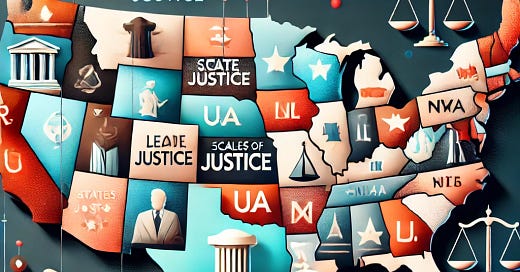State Court Scoop January 2025
From victims’ rights to corporate law, state courts issued rulings in January that could reshape legal protections across the country.
State appellate courts often play a pivotal role in shaping the legal landscape, issuing rulings that influence everything from individual rights and employer liability to corporate governance and election laws. While the U.S. Supreme Court and federal appellate courts attract the most national attention, state supreme courts and intermediate appellate courts regularly decide cases that have profound and immediate effects on residents, businesses, and legal practitioners within their jurisdictions.
In January 2025, state appellate courts delivered a series of significant rulings that clarified legal doctrines, expanded or restricted certain rights, and reshaped key areas of law. Some cases tackled long-standing legal ambiguities, such as North Carolina’s ruling on whether victims of child sexual abuse can revive expired claims under a legislative "lookback window." Others, like Pennsylvania’s decision on employer liability for occupational diseases, redefined the scope of workplace protections and corporate accountability. Meanwhile, cases in states like California and Massachusetts examined emerging legal questions—such as the standing of animals in legal disputes and fiduciary duties in closely held corporations—illustrating how state courts continue to push legal boundaries in different directions.
Despite covering a range of legal topics, several common themes emerged among these decisions:
Legal Doctrines in Flux: Many of these rulings grapple with shifting interpretations of statutory and constitutional provisions, whether concerning tort claims, workers' protections, or business responsibilities. Courts in different states took varied approaches—some expanding rights, others restricting them—demonstrating the diversity in state-level judicial philosophies.
Balancing Individual Rights Against Institutional Power: Multiple cases weighed the rights of individuals against the interests of larger entities such as corporations, employers, or government agencies. While some courts strengthened individual claims—such as those of employees seeking compensation for workplace-related illnesses—others reinforced institutional protections, such as limitations on liability for public and private organizations.
Judicial vs. Legislative Authority: Several decisions involved interpretations of legislative actions, particularly in cases where courts were asked to decide whether lawmakers had overstepped constitutional limits. For instance, rulings on employer liability and victims' rights examined whether state legislatures could retroactively extend statutes of limitations, raising broader constitutional concerns about due process and separation of powers.
Precedents with Nationwide Implications: While these rulings apply within individual states, some have the potential to influence legal debates in other jurisdictions. As states often look to each other for guidance—especially in areas without clear federal precedent—decisions on corporate fiduciary duties, election law, and victims' rights could inspire similar legal battles elsewhere.
Taken together, the cases examined below illustrate the evolving nature of law and the critical role state courts play in defining legal protections and obligations. After going through data about all decisions for the month, the remainder of the article focuses on the top eight decisions that state appellate courts released in January.
State Supreme Court Data
Since many of the written decisions of state supreme courts are summary affirmances, I focused on decisions that ran more than 100 words. First a look at the number of decisions by court.
Interestingly, Montana has the most decisions. This shows a bit about how discretionary case selection plays a role in the number of decisions coming from each court. California, which has a much larger overall appeal load had the fifth most decisions in January as it can select many of the cases it hears. New York and Texas are at the bottom of the chart while Florida has the second most decisions and is the only court side from Montana with over 100 decisions for the month.






